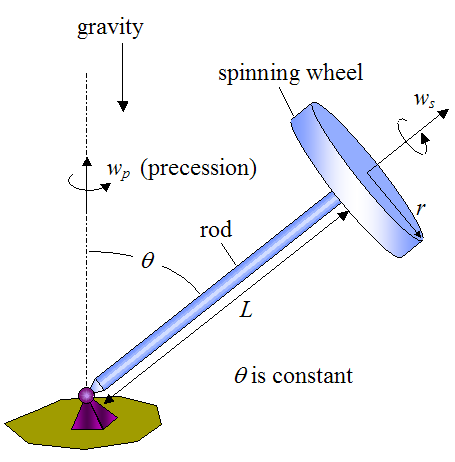Gyroscope physics is one of the most difficult concepts to understand in simple terms. When people see a spinning gyroscope precessing about an axis, the question is inevitably asked why that happens, since it goes against intuition. But as it turns out, there is a fairly straightforward way of understanding the physics of gyroscopes without using a lot of math.
But before I get into the details of that, it's a good idea to see how a gyroscope works (if you haven't already). Click on the link below to see a video of a toy gyroscope in action.
http://www.youtube.com/watch?v=cquvA_IpEsA (opens in new window)
To purchase a gyroscope like the one shown in the video, click on the image link below. You will be taken to an online store, where you can make your purchase.

Original Gyroscope - $ 6.50
From: InnovaToys & Gifts
As you've probably noticed, a gyroscope can behave very similar to a spinning top. Gyroscope physics can therefore be applied directly to a spinning top.
To start off, let's illustrate a typical gyroscope using a schematic as shown below.

Where:
ws is the constant angular velocity of the spinning wheel, in radians/second
wp is the constant rate of precession, in radians/second
L is the length of the rod
r is the radius of the wheel
θ is the angle between the vertical and the rod (a constant)
As the wheel spins at a rate ws, the gyroscope precesses at a rate wpabout the pivot at the base (with θ constant).
The question is, why doesn't the gyroscope fall down due to gravity?!
The reason is this:
Due to the combined rotation ws and wp, the particles in the top half of the spinning wheel experience a component of acceleration a1 normal to the wheel (with distribution as shown in the figure below), and the particles in the bottom half of the wheel experience a component of acceleration a2 normal to the wheel in the opposite direction (with distribution as shown). Due to Newton's second law, this means that a net force F1 must act on the particles in the top half of the wheel, and a net force F2 must act on the particles in the bottom half of the wheel. These forces act in opposite directions. Therefore a clockwise torque M is needed to sustain these forces. The force of gravity pulling down on the gyroscope creates the necessary clockwise torque M.

In other words, due to the nature of the kinematics, the particles in the wheel experience acceleration in such a way that the force of gravity is able to maintain the angle θ of the gyroscope as it precesses. This is the most basic explanation behind the gyroscope physics.
As an analogy, consider a particle moving around in a circle at a constant velocity. The acceleration of the particle is towards the center of the circle (centripetal acceleration), which is perpendicular to the velocity of the particle (tangent to the circle). This may seem counter-intuitive, but the lesson here is that the acceleration of an object can act in a direction that is very different from the direction of motion. This can result in some interesting physics, such as a gyroscope not falling over due to gravity as it precesses.
Now, since it takes a torque to change the orientation of a spinning wheel, an extension of this is that a stationary spinning wheel will tend to remain stationary, and will resist any attempt to change its orientation. This is why gyroscopes are commonly used in navigation, such as in boats and ships. They tend to remain level even if the boat or ship changes orientation (either by pitching or rolling). Such gyroscopes work by mounting a spinning wheel (powered by a motor) in a gimbal (metal frame). The spinning wheel is mounted in the gimbal so as to be free of external torque, therefore it tends to maintain its level orientation as the boat, or ship rocks. The figure below illustrates a gyroscope-gimbal unit.

So now that we have an intuitive "feel" for gyroscope physics, we can analyze it in full using a mathematical approach. We will hence determine the equation of motion for the gyroscope.
Sent from my iPad
No comments:
Post a Comment